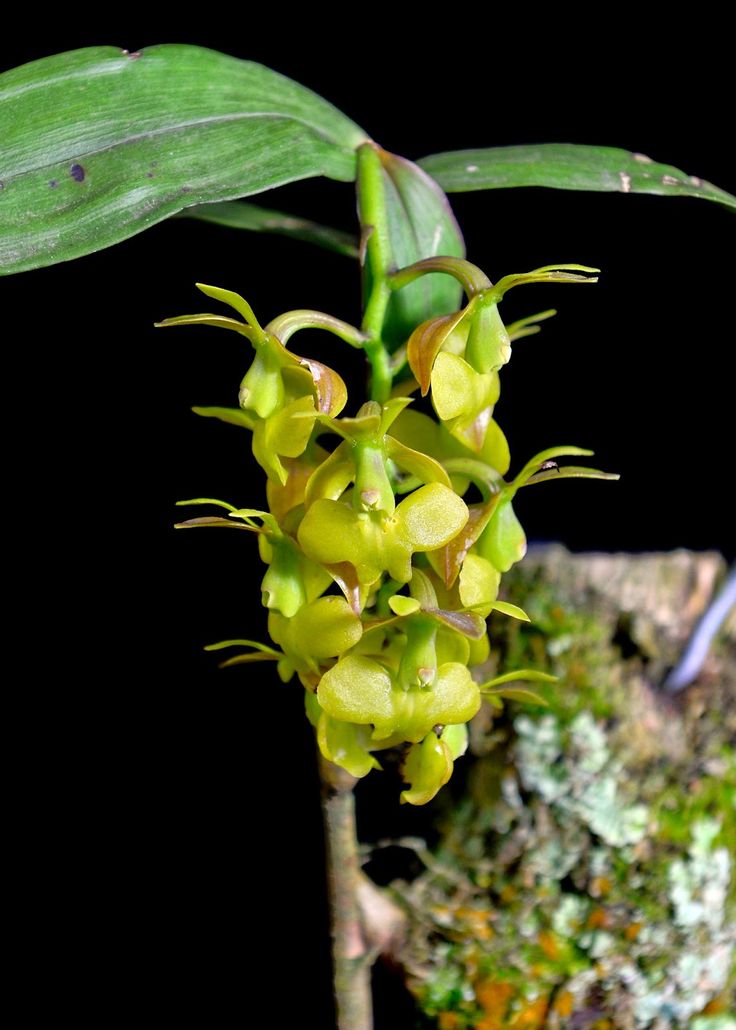

Epidendrum homoion Hágsater & Dodson 1993 GROUP Arbuscula SUBGROUP Incomptum
Photo by © The Species Identification Task Force Website
TYPE Drawing by © Jimenez, Hágsater & E.Santiago and The AMO Herbario Website

 LATE
LATE 
Common Name The Similar Epidendrum [refers to its similarity to others in this group]
Flower Size .8" [2 cm]
Found in Napo province of Ecuador on trees in rolling pastures at elevations around 1800 meters as a large sized, cool growing epiphyte with simple, cane-like, straight, arising from the middle internode of the previous stem carrying 3 to 6, all towards the apex, elliptic, membraneous, clearly visible veined leaves that blooms in the late spring on a terminal, arising on a mature stem, occuring only once, arcuate, racemose, simultaneously 1 to 19 flowered inflorescence with much shorter than the ovary, triangular, acute floral bracts and carrying resupinate flowers with the tepals green and the lip olive green to purplish green.
"Epidendrum homoion is part of GROUP Arbuscula SUBGROUP Incomptum which is characterized by the erect habit with successive lateral growths produced from the middle of the previous growth, few leaves aggregate towards the apex of the stems, roots produced generally only from the base of the primordial stem, inflorescences are short with fleshy yellowish to green to violet-green to black flowers with short ovaries, the lip entire to 3-lobed. The species is superficially similar to E. incomptum Rchb. f. , E. evelynae Rchb. f., E.lechleri Rchb. f., E. morganii Dodson & Garay, and E. yambalense Hágsater & Dodson. The plants are not very strong, the leaves being thin and the veining clearly visible. The lip with large semiorbicular lateral lobes and subquadrate midlobe is similar to E. incomptum, which has the midlobe acute, not emarginate. Epidendrum yambalense has acute segments, narrower lateral lobes and apiculate midlobe. Epidendrum homoion is also similar to E. curtisii A.D. Hawkes, E. superpositum Garay and E. tamaense Foldats, all of which have an emarginate midlobe, but these species can all be distinguished by the differently proportioned floral parts." Hagsater etal
Synonyms
References W3 Tropicos, Kew Monocot list , IPNI ; * Icones Orchidacearum 2 Plate 145 Hagsater & Dodson 1993 drawing fide; Icones Orchidacearum 7 Plate 768 Hagsater and Sanchez 2004 see recognition section; Icones Orchidacearum 7 Plate 779 Hagsater and Sanchez 2004 see recognition section; Icones Orchidacearum Vol 8 Plate 891 Hagsater & Sanchez 2006 see recognition section; Icones Orchidacearum 9 Plate 927 Hagsater 2007 see recognition section; Icones Orchidacearum 9 Plate 974 Hagsater 2007 see recognition section; Icones Orchidacearum 12 Plate 1210 Hagsater 2009 see recognition section; Icones Orchidacearum 14 Plate 1460 Hagsater & Sanchez 2013 see recognition section; Icones Orchidacearum 15 [1] Plate 1524 Hagsater & Sanchez 2015 see recognition section; Icones Orchidacearum 15 [1] Plate 1537 Hagsater & Sanchez 2015 see recognition section; Icones Orchidacearum 15 [1] Plate 1568 Hagsater & Sanchez 2015 see recognition section; Orquideas, Tesoro de Colombia Vol 2 Ortiz & Uribe 2017 Photo fide; Icones Orchidacearum 16[2] Plate 1675 Hagsater & Sanchez 2018 see recognition section; Icones Orchidacearum 18(2) Plate 1882 Hagsater & Jimenez 2021 see recognition section; Icones Orchidacearum 18(2) Plate 1891 Hagsater & Jimenez 2021 see recognition section
--------------------------------------------------------------------------------------------------------------------------
--------------------------------------------------------------------------------